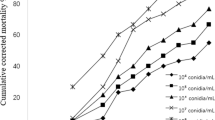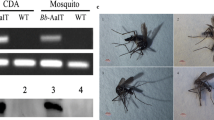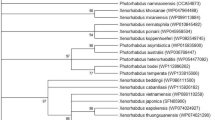Abstract
LqhIT2 is an insect-specific neurotoxin from the venom of scorpion. In this study, the LqhIT2 gene was introduced into the entomopathogenic fungus, Metarhizium acridum. The virulence of the genetically modified strain MaLqhIT2 was then evaluated against locusts (Locusta migratoria manilensis). Compared with the wild-type strain, the median lethal cell density (LC50) for MaLqhIT2 was a 22.6-fold lower, and the median times to death (LT50) for MaLqhIT2 were reduced by 30.3 and 29.6 %, respectively, after topical inoculation and injection. MaLqhIT2 also grew significantly faster in the hemolymph than wild-type strain. There were no significant differences in germination, appressorium formation and sporulation in locust carcasses between the MaLqhIT2 and wild-type strain. These results indicate that LqhIT2 increased the virulence of M. acridum towards locusts by shortening the in vivo infection period, without affecting cuticle penetration or conidia formation in the carcasses. LqhIT2 thus shows considerable potential for increasing fungal virulence against locusts.




Similar content being viewed by others
References
Arnon T, Potikha T, Sher D, Elazar M, Mao W, Tal T, Bosmans F, Tytgat J, Ben-Arie N, Zlotkin E (2005) Bjalphait: a novel scorpion alpha-toxin selective for insects–unique pharmacological tool. Insect Biochem Molec 35:187–195
Beek N, Lu A, Presnail J, Davis D, Greenamoyer C, Joraski K, Moore L, Pierson M, Herrmann R, Flexner L, Foster J, Van A, Wong J, Jarvis D, Hollingshaus G, McCutchen B (2003) Effect of signal sequence and promoter on the speed of action of a genetically modified autographa californica nucleopolyhedrovirus expressing the scorpion toxin LqhIT2. Biol Control 27:53–64
Bennett LV (1975) Development of a desert locust plague. Nature 256:486–487
Bischoff JF, Rehner SA, Humber RA (2009) A multilocus phylogeny of the Metarhizium anisopliae lineage. Mycologia 101:512–530
Charnley AK, Collins SA (2007) Entomopathogenic fungi and their role in pest control. In: Kubicek CP, Druzhinina IS (eds) Environmental and microbial relationships 2nd edition the mycota IV. Springer-Verlag, Berlin Heidelberg, pp 159–187
de Faria MR, Wraight SP (2007) Mycoinsecticides and mycoacaricides: a comprehensive list with worldwide coverage and international classification of formulation types. Biol Control 43:237–256
De Lima ME, Figueiredo SG, Pimenta AM, Santos DM, Borges MH, Cordeiro MN, Richardson M, Oliveira LC, Stankiewicz M, Pelhate M (2007) Peptides of arachnid venoms with insecticidal activity targeting sodium channels. Comp Biochem Phys C 146:264–279
Driver F, Milner RJ, Trueman JWH (2000) A taxonomic revision of Metarhizium based on a phylogenetic analysis of rDNA sequence data. Mycol Res 104:134–150
Fan Y, Borovsky D, Hawkings C, Ortiz-Urquiza A, Keyhani NO (2012) Exploiting host molecules to augment mycoinsecticide virulence. Nat Biotechnol 30:35–37
Fan Y, Fang W, Guo S, Pei X, Zhang Y, Xiao Y, Li D, Jin K, Bidochka MJ, Pei Y (2007) Increased insect virulence in Beauveria bassiana strains overexpressing an engineered chitinase. Appl Environ Microbiol 73(1):295–302
Fang W, Leng B, Xiao Y et al (2005) Cloning of beauveria bassiana chitinase gene bbchit1 and its application to improve fungal strain virulence. Appl Environ Microbiol 71:363–370
Livak KJ, Schmittgen TD (2001) Analysis of relative gene expression data using real-time quantitative PCR and the 2−∆∆CT method. Methods 25:402–408
Federici BA, Bonning BC, St Leger RJ (2008) Improvement of insect pathogens as insecticides through genetic engineering. In: Hill C, Sleator R (eds) PathoBiotechnology. Landes Bioscience, Austin, pp 15–40
Gao QA, Jin K, Ying SH, Zhang YJ, Xiao GH, Shang YF, Duan ZB, Hu XA, Xie XQ, Zhou G, Peng GX, Luo ZB, Huang W, Wang B, Fang WG, Wang SB, Zhong Y, Ma LJ, St Leger RJ, Zhao GP, Pei Y, Feng MG, Xia YX, Wang CS (2011) Genome sequencing and comparative transcriptomics of the model entomopathogenic fungi Metarhizium anisopliae and M. Acridum. Plos Genet 7(1):e1001264
Hunt VL, Charnley AK (2011) The inhibitory effect of the fungal toxin, destruxin a, on behavioural fever in the desert locust. J Insect Physiol 57:1341–1346
Karbat I, Turkov M, Cohen L, Kahn R, Gordon D, Gurevitz M, Frolow F (2007) X-ray structure and mutagenesis of the scorpion depressant toxin LqhIT2 reveals key determinants crucial for activity and anti-insect selectivity. J Mol Biol 366:586–601
Leng Y, Peng G, Cao Y, Xia Y (2011) Genetically altering the expression of neutral trehalase gene affects conidiospore thermotolerance of the entomopathogenic fungus Metarhizium acridum. BMC Microbiol 11:32. doi:10.1186/1471-2180-11-32
Li HB, Xia YX (2008) Expression, antiserum preparation and bioactivity assays of insect neurotoxin LqhIT2. Chin J Biotech 24:1761–1767
Liu YJ, Liu J, Ying SH, Liu SS, Feng MG (2013) A fungal insecticide engineered for fast per os killing of caterpillars has high field efficacy and safety in full season control of cabbage insect pests. Appl Environ Microbiol 79:6452–6458
Lomer CJ, Bateman RP, Johnson DL, Langewald J, Thomas M (2001) Biological control of locusts and grasshoppers. Annu Rev Entomol 46:667–702
Lu D, Pava-Ripoll M, Li Z, Wang C (2008) Insecticidal evaluation of beauveria bassiana engineered to express a scorpion neurotoxin and a cuticle degrading protease. Appl Microbiol Biotechnol 81:515–522
Pava-Ripoll M, Posada FJ, Momen B, Wang C, St Leger R (2008) Increased pathogenicity against coffee berry borer, hypothenemus hampei (coleoptera: Curculionidae) by Metarhizium anisopliae expressing the scorpion toxin (aait) gene. J Invertebr Pathol 99:220–226
Peng G, Wang Z, Yin Y, Zeng D, Xia Y (2008) Field trials of Metarhizium anisopliae var. Acridum (ascomycota: Hypocreales) against oriental migratory locusts, locusta migratoria manilensis (meyen) in northern china. Crop Prot 27:1244–1250
Peng G, Xia Y (2011) The mechanism of the mycoinsecticide diluent on the efficacy of the oil formulation of insecticidal fungus. Biocontrol 56:893–902
Qin Y, Ying SH, Chen Y, Shen ZC, Feng MG (2010) Integration of insecticidal protein vip3aa1 into beauveria bassiana enhances fungal virulence to spodoptera litura larvae by cuticle and per os infection. Appl Environ Microbiol 76:4611–4618
Roberts DW, St Leger RJ (2004) Metarhizium spp., cosmopolitan insect-pathogenic fungi: mycological aspects. Adv Appl Microbiol 54:1–70
Samuels RI, Charnley AK, Reynolds SE (1988) The role of destruxins in the pathogenicity of 3 strains of Metarhizium anisopliae for the tobacco hornworm manduca sexta. Mycopathologia 104:51–58
St Leger RJ, Joshi L, Bidochka MJ, Roberts DW (1996) Construction of an improved mycoinsecticide overexpressing a toxic protease. Proc Natl Acad Sci USA 93:6349–6354
St Leger RJ, Wang C (2010) Genetic engineering of fungal biocontrol agents to achieve greater efficacy against insect pests. Appl Microbiol Biotechnol 85:901–907
Wang C, Leger RJS (2006) A collagenous protective coat enables Metarhizium anisopliae to evade insect immune responses. Proc Natl Acad Sci USA 103:6647–6652
Wang C, St Leger RJ (2007) A scorpion neurotoxin increases the potency of a fungal insecticide. Nat Biotechnol 25:1455–1456
Wang S, O’Brien TR, Pava-Ripoll M, St Leger RJ (2011) Local adaptation of an introduced transgenic insect fungal pathogen due to new beneficial mutations. Proc Natl Acad Sci USA 108:20449–20454
Wu LF (1951) Locusts of China. Yong Xiang Press, Shanghai
Zilberberg N, Zlotkin E, Gurevitz M (1992) Molecular analysis of cDNA and the transcript encoding the depressant insect selective neurotoxin of the scorpion leiurus quinquestriatus hebraeus. Insect Biochem Molec 22:199–203
Zlotkin E, Eitan M, Bindokas VP, Adams ME, Moyer M, Burkhart W, Fowler E (1991) Functional duality and structural uniqueness of depressant insect-selective neurotoxins. Biochemistry-Us 30:4814–4821
Acknowledgments
This work was supported by a grant from the High Technology Research and Development Program (863) of China (No. 2011AA10A204), the Natural Science Foundation of China (No. 31071730) and the Natural Science Foundation Project of CQ CSTC (No. CSTC2012 JJB 80002).
Author information
Authors and Affiliations
Corresponding authors
Rights and permissions
About this article
Cite this article
Peng, G., Xia, Y. Expression of scorpion toxin LqhIT2 increases the virulence of Metarhizium acridum towards Locusta migratoria manilensis . J Ind Microbiol Biotechnol 41, 1659–1666 (2014). https://doi.org/10.1007/s10295-014-1497-1
Received:
Accepted:
Published:
Issue Date:
DOI: https://doi.org/10.1007/s10295-014-1497-1




